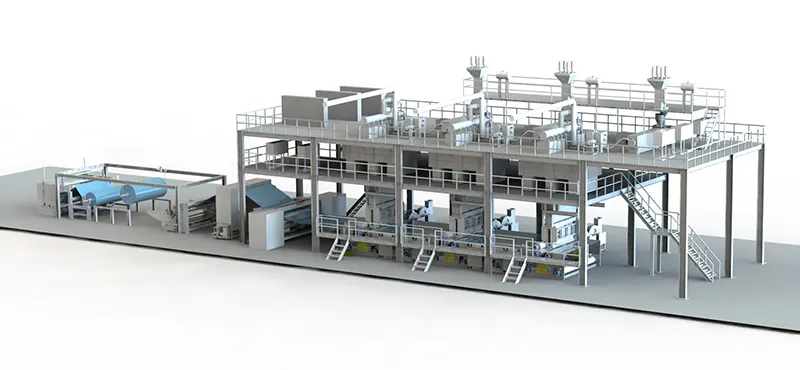Several technological advancements are expected in non-woven machinery, aiming to improve efficiency, versatility, and sustainability in fabric production.
Some anticipated advancements include:
- Nano and Microfiber Technologies: Advancements in producing nano or microfibers using innovative techniques like electrospinning or nanofiber spinning could lead to fabrics with enhanced filtration capabilities or specialized functionalities.
- Smart Manufacturing and Industry 4.0 Integration: Non-woven machinery is likely to integrate further with smart manufacturing concepts, utilizing IoT (Internet of Things), AI (Artificial Intelligence), and data analytics to optimize processes, reduce waste, and enhance productivity.
- Advanced Composite Materials: Development of machinery capable of creating composite non-woven fabrics with a combination of materials, structures, or functionalities tailored for specific applications, such as aerospace or medical textiles.
- Precision and Customization: Machinery advancements may allow for more precise control over fiber alignment, density, and fabric properties, enabling customization and production of highly tailored non-woven materials.
- Energy-Efficient Processes: Continued focus on energy-efficient technologies, such as more eco-friendly bonding methods or reduced energy consumption during production, to align with sustainability goals.
- Biodegradable and Sustainable Fabrics: Machinery innovations may facilitate the production of non-woven fabrics using eco-friendly and biodegradable materials, meeting the growing demand for sustainable textiles.
- Automation and Robotics: Further integration of automation and robotics into non-woven machinery to streamline processes, improve accuracy, and reduce reliance on manual labor, enhancing efficiency and consistency.
- Hybrid Fabric Production: Advancements in machinery capable of seamlessly combining various non-woven processes within a single production line, nonwoven machinery manufacturers enabling the creation of hybrid fabrics with multifunctional properties.
- Sensor Integration and Quality Control: Enhanced sensor technologies within machinery for real-time monitoring and quality control, ensuring fabric uniformity, strength, and compliance with standards.
- Flexible and Scalable Manufacturing Systems: Machinery designed for more flexible and scalable manufacturing setups, allowing facilities to adapt quickly to changing market demands and production requirements.
These anticipated advancements in non-woven machinery aim to address industry challenges, drive innovation, and meet evolving consumer demands for high-performance, sustainable, and customized non-woven fabrics across diverse applications.
How does the maintenance of non-woven machinery impact the overall production process?
The maintenance of non-woven machinery plays a crucial role in ensuring the overall efficiency, reliability, and quality of the production process:
- Equipment Reliability: Regular maintenance schedules and proper upkeep contribute to the machinery’s reliability, reducing unexpected breakdowns and downtime during production.
- Consistent Production: Well-maintained machinery operates more consistently, maintaining desired parameters such as speed, tension, and temperature, which are essential for producing consistent, high-quality fabrics.
- Optimal Performance: Regular maintenance ensures that machinery operates at peak performance levels, maximizing output and minimizing inefficiencies that could lead to subpar fabric quality or production delays.
- Longevity of Equipment: Proper maintenance extends the lifespan of machinery components, reducing the need for frequent replacements and costly repairs, which can interrupt production schedules.
- Cost Efficiency: Preventive maintenance reduces the likelihood of major breakdowns or failures, avoiding costly emergency repairs and production downtime, thus saving on repair expenses and loss of revenue.
- Safety and Compliance: Maintaining machinery in good condition ensures a safer working environment for operators and helps meet safety standards and regulatory compliance.
- Quality Control: Machinery maintenance contributes to consistent fabric quality by ensuring that equipment operates within specified tolerances, minimizing variations or defects in the fabrics produced.
- Employee Training and Skills: Maintenance activities often involve regular checks and servicing performed by skilled technicians, fostering a culture of continuous learning and improving the technical skills of the workforce.
- Predictive Maintenance Benefits: Implementation of predictive maintenance techniques, such as monitoring equipment through sensors or data analytics, helps anticipate potential issues and plan maintenance proactively, reducing unexpected downtime.
- Process Optimization: During maintenance checks, opportunities for process optimization or machinery upgrades may be identified, leading to enhanced efficiency and productivity.
In summary, effective maintenance of non-woven machinery is critical for ensuring consistent, high-quality fabric production, minimizing downtime, optimizing performance, reducing operational costs, and extending the lifespan of equipment.
